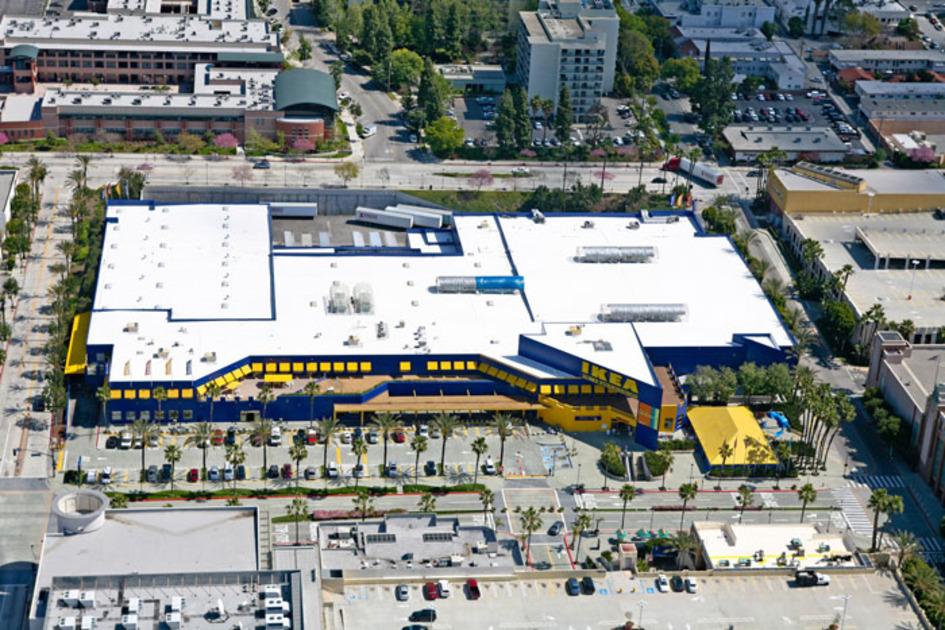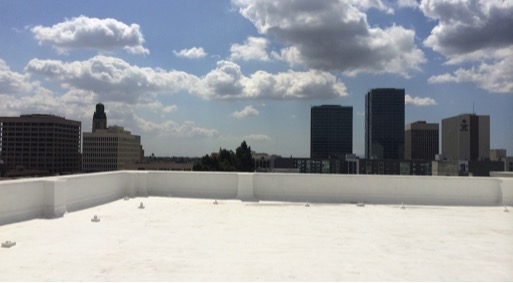Using Reflective Coatings to Create an Energy Efficient Roof

By Western Colloid.
If your roof is aging, a reflective coating may be an option to not only extend its life, but add energy efficient benefits at the same time.
Let’s talk about what ages a roof. On its own, the materials that make up commercial roofing systems are extremely durable. Without outside forces, the components of a commercial roof are meant to last decades. So, what are the reasons roofs degrade?
-
Water. This is the big one. Whether precipitation, leaks from rooftop equipment or ponded water that doesn’t drain, water is incredibly destructive. If it can find opportunities to enter your building through cracks in the roof, it can lead to structural damage, poor indoor air quality and mold growth.
-
Traffic. Most people tend to think of roofs as out of sight, out of mind, but if your roof has regular foot traffic, whether from maintenance staff or more elaborate purposes like a helicopter pad, then you have to be aware of the impact those feet will have on your roof’s surface.
-
Improper installation. A roof is a big investment, so choosing a contractor who knows their business and who will help you select a roof system that is compatible with what you already have and install it properly is critical to avoiding issues like premature failure.
-
Extreme temperatures. As the temperature rises and falls, your roof will expand or contract and can undergo with extreme fluctuations thermal shock. With most roofing systems the flashings, elastic cement and roof membranes are made of different materials, they expand and contract at different rates, which can lead to cracks.
-
Hail. Although infrequent in most parts of the country, a good hail storm can do more serious damage to a roof than an entire winter’s worth of ice and snow. Hail impacts can crack and perforate several layers of a roofing system.
-
Sun. Heat and UV rays will age your roof by contributing to that thermal expansion on hot days, as well as the overall degradation of the materials.
Protect Your Roof and Improve Your Energy Efficiency

Maintaining your roof is all about cost-benefit analysis. Replacing your roof system is costly and potentially disruptive, so you want to keep it in good repair to ensure it lasts as long as possible. But even with a proactive maintenance program, your roof could be costing you money unnecessarily.
Traditionally, most roof systems are finished in dark colors like black and dark gray. This is because of the materials they use, like tar, asphalt and gravel. If you’ve ever stood on a dark driveway on a hot day, you know how much heat dark building materials can absorb — and even hold onto once the sun is down.
If your dark-colored roof is absorbing heat and UV rays, it’s not only aging, it’s increasing the load on your building’s cooling system. That heat has to go somewhere, and occupied spaces fit the bill nicely. So your aging dark roof could be costing you money in energy usage and air conditioning without you even being aware of it.
Protect Your Building and Save Money With a Reflective Roof Coating

As we’ve already discussed, replacing your roof can be costly and disruptive, especially in an occupied building. If you are looking to protect your relatively new roofing system from damaging UV or simply looking for ways to improve your building’s overall energy efficiency, a reflective roof coating is an affordable way to do it.
Or if you have an aging roof that’s close to replacement, a reflective coating system may be a good solution with faster installation timelines than a traditional tear off and replace or build up.
Reflective roof coatings are typically installed as part of a Fluid Applied Reinforced Roof (FARR) system. Liquid roof coating is applied between layers of reinforced polyester fabric. The coating can go on using a roller or as a spray for large areas.
Typically, reflective coatings are white. This color is the key to its energy efficiency. White coatings reflect, rather than absorb, heat and UV rays. Western Colloid’s reflective coatings can reflect anywhere between 76 and 84% of the sun’s rays, drastically reducing the heat load on your building.
Choose the Right Reflective Coating for Your Building

Reflective coatings can be applied over your existing roof, which saves significant time and money, but you need to make sure the coating you select is compatible with your existing substrate. Choosing the wrong coating, or applying it without determining if a primer is necessary, will often lead to poor adhesion, water intrusion and premature failure.
Western Colloid offers four different white acrylic reflective coatings. Each is designed to work with specific conditions and roof systems:
#720 AFC Elastahyde: Acrylic Premium-Grade Elastomeric Reflective Coating
Water-based, this product is ideal as a topcoat for a FARR system. Plus, it meets CA Title-24. Specially formulated for coating existing SPF roofs, ARC Elastahyde has less bleed through over asphaltic surfaces.
It is also available in #720 QS, a quick set formulation. This special formulation aids in the application of ElastaHyde when damp, wet or rainy weather is expected before the ElastaHyde has proper time to completely dry.
#790 AFC ElastaHyde – 790: Acrylic Premium-Grade Elastomeric Reflective Coating
Water-based, this product is formulated for use over EPDM surfaces. We recommend it for use in cold regions. It’s also excellent for use on new, uncoated SPF systems.
#770 AXP ElastaHyde -770: Acrylic Elastomeric Base Coating
Water-based, this product is formulated for resistance to ponding water. It cures faster than most acrylic coatings, and it is excellent as a base coat over smooth, asphaltic surfaces.
#700 EC Western White: Acrylic Economy-Grade Elastomeric Reflective Coating
#700 EC WesternWhite is an acrylic, elastomeric coating designed to be used when cost is a factor. It is ideal for prolonging roof life.
All these coatings meet the ENERGY STAR® guidelines for energy efficiency and savings. When the right reflective coating is applied, building owners can enjoy significant energy savings and increased longevity of their roof system.
To learn more about our products, visit the Western Colloid website.
Original article source: Western Colloid























Comments
Leave a Reply
Have an account? Login to leave a comment!
Sign In